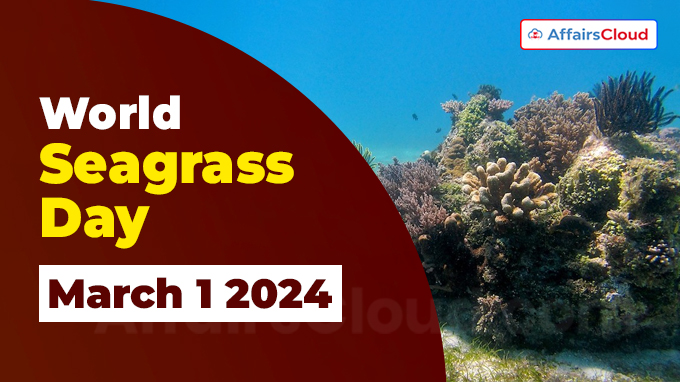 The United Nations (UN)’s World Seagrass Day is annually observed across the globe on 1 March to raise awareness of the significance of seagrasses, emphasising their fundamental role in marine biodiversity, their threats, and their contributions to sustainable development and climate change mitigation and adaptation.
The United Nations (UN)’s World Seagrass Day is annually observed across the globe on 1 March to raise awareness of the significance of seagrasses, emphasising their fundamental role in marine biodiversity, their threats, and their contributions to sustainable development and climate change mitigation and adaptation.
- This Day serves as a platform to foster actions aimed at conserving seagrasses, supporting their growth and health, and recognising their vital role in achieving Sustainable Development Goals (SDGs).
1 March 2024 marks the observance of the 2nd World Seagrass Day.
Objective:To emphasise the role of Seagrass in achieving the objectives of the UN Framework Convention on Climate Change (UNFCCC) and the Paris Agreement.
Background:
i.On 23 May 2022, the UN General Assembly (UNGA) adopted the resolution A/RES/76/265 and proclaimed the 1st March of every year as World Seagrass Day.
ii.UNGA also invited the UN Environment Programme (UNEP) to facilitate the observance of the Day.
iii.The first ever World Seagrass Day was observed on 1st March 2023.
What is Seagrass?
i.Seagrasses are marine flowering plants (angiosperms) that grow submerged in shallow marine waters.
- They are often described as the ‘lungs’ of the sea.
ii.It helps maintain water quality and is known for providing many ecosystem services. They are considered to be ‘Ecosystem Engineers’.
iii.Covering a mere 0.1% of the ocean floor, these meadows play a pivotal role in marine biodiversity and ecological balance.
Key Facts:
i.Seagrass meadows exist in the coastal waters of 159 countries on 6 continents, covering over 300,000 square kilometers (km2).
ii.With 72 distinct species worldwide, seagrass evolved from terrestrial grass over 70 million years ago.
iii.It keeps oceans clean and healthy by absorbing harmful nutrients and reducing the incidence of pathogenic marine bacteria by 50%.
iv.It supports fisheries and tourism, with 20% of major fisheries dependent on seagrass.
v.Seagrass meadows are incredibly effective carbon sinks and store up to 18% of the world’s oceanic carbon.
vi.Seagrass meadows are among the least protected coastal ecosystems.
- Only 26% of seagrass meadows fall within marine protected areas, lagging behind coral reefs (40%) and mangroves (43%).
A Resource in Danger:
Global Decline: Since the 1930s, seagrasses have diminished globally, with an alarming 7% loss annually, equivalent to losing a football pitch every 30 minutes.
- Almost 30% of global seagrass areas have been lost since the late nineteenth century.
Conservation Status:
Notably, 21% of seagrass species are listed as Near Threatened, Vulnerable, or Endangered Species under the International Union for Conservation of Nature (IUCN) Red List of Threatened Species.
Threats to Seagrass:
Human-Induced Threats: Coastal development; urban, industrial, and agricultural run-off; pollution; climate change; dredging; and unregulated fishing are key contributors to seagrass degradation.
Global Restoration Efforts:
i.As part of the UN Decade on Ecosystem Restoration (2021-2030), international projects aim to revive seagrass ecosystems.
ii.Restoration projects from Gazi Bay (Kenya) to Maputo Bay (Mozambique) and Dale Bay (Wales) signal a global effort.
Note: Conserving and restoring seagrass meadows can help nations achieve 26 targets and indicators associated with 10 SDGs.




